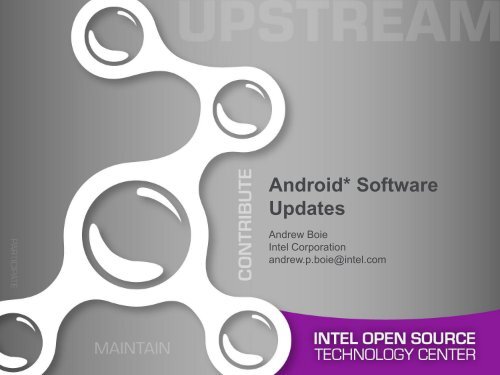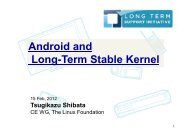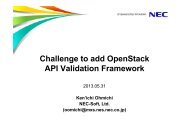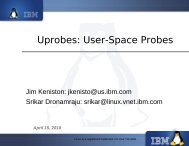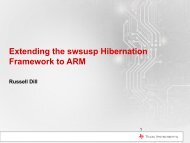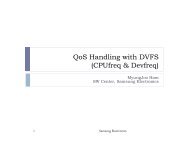Android Software Updates - The Linux Foundation
Android Software Updates - The Linux Foundation
Android Software Updates - The Linux Foundation
You also want an ePaper? Increase the reach of your titles
YUMPU automatically turns print PDFs into web optimized ePapers that Google loves.
<strong>Android</strong>* <strong>Software</strong><br />
<strong>Updates</strong><br />
Andrew Boie<br />
Intel Corporation<br />
andrew.p.boie@intel.com
Agenda<br />
• Introduction<br />
• Filesystem Configuration<br />
• Releasetools<br />
• Recovery Console<br />
• Updater<br />
• SW Update Lifecycle<br />
• Wrap-up<br />
2
3<br />
INTRODUCTION
Capabilities<br />
• Full Image SW <strong>Updates</strong><br />
– <strong>Updates</strong> from any compatible prior SW version<br />
– At creation time, can set flag to enforce rollback protection; older SW versions cannot be installed on top of newer<br />
ones<br />
• Incremental SW <strong>Updates</strong><br />
– bsdiff patching on a per-file basis for contents of /system and boot images<br />
– Typically much smaller than a full image update<br />
• <strong>Updates</strong> all partitions and boot images<br />
– Extensible to update special firmware or baseband software via plug-ins<br />
• ASLR<br />
– Address Space Layout Randomization<br />
– Binaries written to the device during update are ‘retouched’<br />
• Update zip files have embedded digital signature<br />
– verified by android.os.RecoverySystem.verifyPackage() API and also the RC<br />
• Safely restartable in the event of a power loss<br />
– Patched files are swapped with originals with rename()<br />
– Device keeps booting into RC until process is complete<br />
– RC itself updated after SW update is done and booted into new <strong>Android</strong> image via oneshot flash-recovery init<br />
service<br />
• At creation time, updates can be configured to force Factory Data Reset in case update has<br />
incompatible userdata<br />
– In a perfect world, only used during development, end users will hate you<br />
• Updater program which actually applies the update lives inside the signed SW update package<br />
and not on the device<br />
4
AOSP <strong>Software</strong> Update Components<br />
• Releasetools<br />
– Create digitally signed software updates from a target-files-package (TFP)<br />
• TFP generated by <strong>Android</strong>* build system<br />
– Substitute testing for production keys inside a TFP<br />
• android.os.RecoverySystem APIs<br />
– Framework APIs to verify & install SW updates<br />
– Handles verification of OTA update digital signature<br />
– Writes RC command files into /cache/recovery and reboots into Recovery Console<br />
– Also used to engage Factory Data Reset<br />
• Recovery Console (RC)<br />
– Alternate boot environment<br />
– Verify & Apply SW updates<br />
– Perform Factory Data Reset<br />
– Typically controlled by command files left by RecoverySystem APIs<br />
– Hidden menu for manual interaction<br />
• Updater<br />
– SW update logic, binary inside SW update package<br />
– AOSP implementation runs script in Edify language<br />
– Platform-specific tasks implemented in plug-ins<br />
• SW Update UI intent from Settings application<br />
5
Missing Pieces<br />
• Not all components for an end-to-end solution are open source<br />
– Remote server backend to host updates (the Server)<br />
– Client-side mechanism to check and download updates (the Fetcher)<br />
– Client-side notification UI that SW <strong>Updates</strong> are available (the Notifier)<br />
• Clearly defined layers of abstraction should make these more or less<br />
drop-in<br />
– Only the server and fetcher care about OTA protocol unless part of a larger<br />
device management framework like OMA-DM<br />
– Fetcher/Notifier in most cases the same APK<br />
– Works with rest of the SW Update system via android.os.RecoverySystem APIs<br />
– Settings app integration:<br />
• Notifier APK should have activity with intent filter for<br />
android.settings.SYSTEM_UPDATE_SETTINGS to check for updates<br />
– Launched when user clicks About tablet -> System <strong>Updates</strong><br />
– BootReceiver to check for RC messages in /cache/recovery<br />
– No other framework modifications should be necessary<br />
• Any vendor that proposes invasively hacking up the framework to support OTA should<br />
be regarded with extreme suspicion unless they are doing OMA-DM<br />
6
Limitations<br />
• No support for disk re-partitioning<br />
– Leave lots of slack space in /system for future <strong>Android</strong> releases<br />
– Leave slack space in boot and recovery partitions for future boot images<br />
– /cache should be large enough to hold a compressed SW update, two-thirds of<br />
/system size to be safe<br />
• One update applied at a time<br />
• Device can’t be used while updates are applied<br />
7
8<br />
FILESYSTEM CONFIGURATION
Partition Layout<br />
• boot<br />
– AOSP boot image<br />
– <strong>Linux</strong> kernel and ramdisk mounted as root filesystem<br />
– Contains init and essential tools to mount /system and boot the rest of <strong>Android</strong><br />
• system<br />
– All <strong>Android</strong> system applications and libraries<br />
– Always mounted read-only except in context of an OTA update<br />
• Incremental updates depend on /system being in a specific state<br />
• data<br />
– Downloaded applications<br />
– Application data<br />
– Dalvik cache<br />
– Typically not touched by OTA updates<br />
– Erased by Factory Data Reset<br />
9
Partition Layout (continued)<br />
• recovery<br />
– Alternate AOSP boot image<br />
– Ramdisk contains ‘recovery’ program which is the RC implementation<br />
• misc<br />
– Very small size, does not contain a filesystem<br />
• Has Bootloader Control Block (BCB) written directly to the block device node<br />
– Used to communicate between RC and the bootloader<br />
• cache<br />
– Temporary storage, contents can be erased at any time<br />
– Used by some applications as a temporary storage/download area<br />
• Requires special APK permissions<br />
– Downloaded OTA updates stored here<br />
– Used as temporary storage by applypatch<br />
– Erased during Factory Data Reset<br />
10
<strong>Android</strong> Boot Images<br />
• Container file format, with metadata, kernel image, ramdisk, and<br />
optional 2 nd -stage bootloader image<br />
• Created by system/core/mkbootimg<br />
• Used in two places<br />
– Called by the build system to create boot images in $OUT as part of a normal<br />
build<br />
– Also created by Releasetools when assembling an OTA update from a targetfiles-package<br />
• Projects that have special boot image types should override/extend<br />
mkbootimg<br />
11
ecovery.fstab<br />
• Specification file for all the filesystems on the device<br />
– Not a partitioning specification, no offset/ordering/partition size information<br />
• Used by RC and Releasetools<br />
• Maps mount points to device nodes and filesystem types<br />
• length= argument to specify filesystem size (not partition)<br />
– Defaults to fill partition when formatted by RC<br />
– Negative argument fills partition minus specified amount, typically used to leave<br />
16K at the end of /data to support encryption<br />
– Otherwise, format the partition to specified size<br />
12
<strong>Software</strong> Update Creation<br />
RELEASETOOLS<br />
13
Target-Files-Package (TFP)<br />
• Created by ‘make target-files-package’<br />
– Build logic in build/core/Makefile<br />
• Zip file containing snapshot of a particular SW release, everything<br />
needed to create an OTA update<br />
– A single TFP used to create a full image update<br />
– Two TFPs used to create an incremental update<br />
• Add additional device-specific blobs by defining “radio files”<br />
– Seems to be a legacy name, doesn’t necessarily have anything to with device’s<br />
radio<br />
– In <strong>Android</strong>Board.mk:<br />
• $(call add-radio-file,myblob.dat)<br />
– Ends up in target-files-package in RADIO/ directory<br />
– Platform-specific extensions to Releasetools will handle these files<br />
14
<strong>Android</strong> Security<br />
• All APKs are digitally signed<br />
– <strong>Updates</strong> to the same application must be signed by the same key otherwise app data<br />
will be inaccessible<br />
– Apps that want to share the same user ID must be signed with the same key<br />
– LOCAL_CERTIFICATE specifies the key; defaults to testkey<br />
• OTA updates will be discarded if not signed with one of the expected<br />
keys<br />
• AOSP has four keys in build/target/product/security<br />
– Testkey: Default key to sign APKs<br />
– Platform: Core platform packages are signed with this<br />
– Shared: Data sharing between Home and Contacts processes<br />
– Media: Packages in the media/download system<br />
• 2048-bit RSA keys with public exponent 3. Created with openssl<br />
• Cannot ship a product with the AOSP keys that are in the build<br />
– Test keys should only be used during development, enforced by CTS case<br />
– sign_target_files_apks tool in Releasetools used to swap out the AOSP test<br />
keys in the TFP with the real production keys<br />
• Re-signs all APK files with new keys<br />
• Swaps out OTA verification key in RC ramdisk<br />
15
ota_from_target_files<br />
• Lives with the rest of the Releasetools in build/tools/releasetools<br />
• Script to create OTA updates from one or more TFPs. Some useful options:<br />
– --incremental-from <br />
• creates an incremental update from a source TFP<br />
– --wipe-user-data<br />
• OTA package will erase /data when installed<br />
– --no_prereq<br />
• Disable rollback protection checks<br />
– --package_key<br />
• Key to use to sign the package; defaults to testkey<br />
• For most platform-specific update tasks, Python extensions can be implemented to<br />
perform additional tasks in the update<br />
• Creates a SW update package containing all images, updater binary, and Edify script<br />
that updater interprets to apply the SW update<br />
• TFP not normally contain built boot images<br />
– Boot image components included (bzImage, ramdisk contents, 2 nd -stage bootloader) so that<br />
ota_from_target_files can generate them<br />
– Intermediate step: sign_target_files_apks modifies TFP to substitute test keys with production keys<br />
– GetBootableImage() does look for prebuilt boot images under BOOTABLE_IMAGES/ in the TFP, but no way<br />
to substitute the OTA keys in a prebuilt RC boot image with sign_target_files_apks!<br />
• No support in build system, would have to manually place in TFP<br />
• Would have to build them with production keys already inside RC ramdisk<br />
16
SW Update Creation<br />
<strong>Android</strong><br />
Build<br />
Optional, to create<br />
Incremental update<br />
TFP<br />
(Test Keys)<br />
Source SW<br />
TFP<br />
Re-Sign<br />
APKs<br />
TFP<br />
Generate SW<br />
Update<br />
SW Update<br />
sign_target_files_apks<br />
ota_from_target_files<br />
17
Releasetools Extensions<br />
• “Radio files” specified in <strong>Android</strong>Board.mk will be populated in the TFP<br />
• To extend Releasetools to work with these files, create a Python module with the<br />
following functions<br />
– FullOTA_Assertions()<br />
• Called after emitting the block of assertions at the top of a full OTA package<br />
– FullOTA_InstallEnd()<br />
• Called at the end of full OTA installation<br />
– IncrementalOTA_Assertions()<br />
• Called after emitting the block of assertions at the top of an incremental OTA package<br />
– IncrementalOTA_VerifyEnd()<br />
• Called at the end of the verification phase of incremental OTA installation; put checks here to abort the script<br />
before any changes are made<br />
– IncrementalOTA_InstallEnd()<br />
• Called at the end of incremental OTA installation<br />
– All functions passed an ‘info’ option which has pointers to<br />
• zipfile.ZipFile objects for source and target TFPs, output zip file. Used to move files or create patches<br />
from TFPs and place inside the SW update<br />
• Script object to append additional Edify script commands<br />
• Use ota_from_target_files code as a guide<br />
• Put path to this module in TARGET_RELEASETOOLS_EXTENSIONS in<br />
BoardConfig.mk<br />
• Relevant ota_from_target_files options<br />
– --device_specific path to Releasetools extension module<br />
– --extra to pass additional key/value pairs accessible by Releasetools extension<br />
– --extra_script to directly add commands to the generated updater Edify script<br />
18
Other Releasetools<br />
• img_from_target_files<br />
– TFP as input<br />
– Produces an image zipfile suitable for use with ‘fastboot update’<br />
– Might be better to have Fastboot accept a real SW update and reboot into RC to<br />
apply it<br />
• check_target_files_signatures<br />
– Looks for problems with package signatures inside a TFP<br />
– Can be used to check for compatibility problems between two TFPs (key<br />
changes, etc.)<br />
19
SW Update Alternate Boot Environment<br />
RECOVERY CONSOLE (RC)<br />
20
Recovery Console<br />
• Alternate boot image, a few ways to enter<br />
– reboot recovery from a shell<br />
– RecoverySystem APIs in <strong>Android</strong> Framework<br />
– OEMs often implement a bootloader ‘magic key’<br />
• Pictorial interface, no localization<br />
• Hidden non-localized menu for manual tasks<br />
– Factory Data Reset<br />
– Find and select SW update on SD Card<br />
– Other platform-specific tasks as implemented in Recovery Console UI plug-in<br />
• Log files saved in /cache/recovery<br />
– All stdout/stderr from RC and Updater<br />
– Edify ui_print() commands<br />
21
misc and the BCB<br />
• Tiny partition used for communication between RC and bootloader,<br />
and for RC to save state information<br />
• Contains Bootloader Control Block (BCB)<br />
– command[32]: Commands for the bootloader<br />
• “boot-recovery” boot into RC instead of <strong>Android</strong><br />
• Other platform-specific commands may be implemented for update tasks that must be<br />
done by the bootloader<br />
• If empty, garbage, or no known commands matched, normal <strong>Android</strong> boot<br />
– status[32]: Return status field written by bootloader after performing platformspecific<br />
commands<br />
• No specification, platform-dependent<br />
– recovery[1024]: Command line for Recovery Console<br />
• Arguments tokenized by ‘\n’<br />
• Invalid if first argument not ‘recovery’<br />
22
Recovery Console Control<br />
• Comments at the beginning of bootable/recovery/recovery.c are out of date<br />
• Upon startup, looks for command line arguments in decreasing precedence:<br />
– Actual command line to ‘recovery’, debug-only scenario<br />
– BCB.recovery<br />
– Command file in /cache/recovery/command (written by RecoverySystem APIs)<br />
• RecoverySystem doesn’t write to BCB due to permissions on doing raw block device I/O<br />
• Always copies arguments into BCB.recovery and sets BCB.command to “bootrecovery”<br />
– Makes sure we keep booting into RC with the same arguments in event of unexpected power<br />
loss<br />
– Don’t rely solely on /cache/recovery/command for this<br />
• finish_recovery()<br />
– Called when requested operations (SW update, factory data reset, etc) are complete,<br />
whether successful or failed<br />
– BCB is cleared so that subsequent reboot goes back into <strong>Android</strong><br />
– Copies all logs to /cache/recovery/<br />
– If no arguments were given to RC, displays error image and waits for menu input<br />
• A divergent update process is very very bad, should always at some point<br />
complete so that finish_recovery() can be called<br />
– Else the device will get stuck, user resets it, gets stuck again, can never boot back into<br />
<strong>Android</strong><br />
23
Bootloader Integration<br />
• <strong>Linux</strong> kernel should write “boot-recovery” into BCB.command<br />
and zero out BCB.recovery if “recovery” is supplied as a reboot()<br />
argument<br />
– Implement in a driver via register_reboot_notifier()<br />
• Bootloader selects boot image (or other task) based on<br />
BCB.command<br />
– BCB.command is persistent; keep booting into RC until RC clears it<br />
– Garbage or zeroed out contents should simply boot into <strong>Android</strong><br />
24
Recovery Console UI Plug-in<br />
• Device-specific policy and extensions for RC<br />
– Copy bootable/recovery/default_recovery_ui.c into your<br />
$(TARGET_DEVICE_DIR) space and create as a static library<br />
– Set TARGET_RECOVERY_UI_LIB in BoardConfig.mk to the<br />
$(LOCAL_MODULE) for this library<br />
• Capabilities<br />
– Define additional menu items<br />
• Customize MENU_ITEMS[] and add logic to device_perform_action()<br />
– Extra device wiping code implemented in device_wipe_data()<br />
– Customization of branding graphics done in device_ui_init()<br />
– Additional initialization tasks in device_recovery_start()<br />
– Customize effect of keystrokes with device_handle_key()<br />
• Key chords can be implemented by additionally checking ui_key_pressed(code)<br />
– Implementation of device-specific commands in device_perform_action()<br />
– Policy on whether to show the hidden RC menu in<br />
device_toggle_display()<br />
– Policy on whether to reboot on key press in device_reboot_now()<br />
25
Recovery Branding<br />
Portions of this page are reproduced from work created and shared by<br />
Google and used according to terms described in the Creative Commons<br />
3.0 Attribution License.<br />
• Image-only GUI; in case of a<br />
problem user must call customer<br />
care<br />
• Built-in images can be replaced by<br />
putting images in<br />
$(TARGET_DEVICE_DIR)/reco<br />
very/res<br />
– Must be 8-bit PNGs in RGB or<br />
RGBA format<br />
– Keep same filenames<br />
• Number of animation frames for<br />
items, offsets, etc., can be set in<br />
UIParameters struct passed to<br />
device_ui_init() in UI plug-in<br />
• bootable/recovery/makeoverlay.py<br />
script helps create<br />
the base image plus overlay<br />
frames and computed offsets for<br />
animations<br />
26
27<br />
UPDATER
Updater binary<br />
• Lives inside the SW update zip<br />
– No need for security checks since signature of SW update has been verified<br />
– Nice to have this in the zip so that all SW update implementation code doesn’t<br />
need to exist a priori<br />
• Not strictly required to use the updater implementation in AOSP<br />
– RC fork/execs updater and communicates via pipe<br />
– RC passes in 3 arguments<br />
• RC API version (currently 3)<br />
• file descriptor for communication pipe<br />
• path to the SW update zip file<br />
– Updater writes string commands over the pipe to set progress bar parameters or<br />
print strings to the hidden Recovery UI; see bootable/recovery/install.c<br />
• AOSP implementation interprets a script inside the SW update<br />
written in Edify language<br />
• Platform-specific updater capabilities implemented in plug-ins<br />
• Be sure updater terminates! Corner cases where it doesn’t<br />
terminate effectively bricks the device<br />
28
Recovery From Boot<br />
• RC itself is not updated during the course of a SW update<br />
– Makes sure that the same RC (from the source SW version) is used throughout<br />
the update even if power lost<br />
– Useful for key revocation scenarios<br />
• Oneshot init.rc service flash_recovery<br />
– Runs /system/etc/install-recovery<br />
– Checks SHA1 of Recovery image to detect whether it needs to be patched<br />
– No-op if matches patched SHA1<br />
– Applies a patch to the boot image to create the RC image, which is written to the<br />
recovery partition<br />
29
Applypatch<br />
• Used by incremental updates to patch /system files and boot images<br />
• When calculating binary diffs, is able to detect compressed file<br />
headers and break files into chunks<br />
– For gzip, does not work well unless file was compressed with same version of<br />
deflate() algorithm that it has access to<br />
– ‘gzip’ has a much older deflate() than zlib (gzip does not link against zlib, it is<br />
self-contained)<br />
– Hence all ramdisks should be compressed with zlib-linked ‘minigzip’ and so<br />
should bzImages<br />
• May have to hack your kernel build to use minigzip instead of gzip<br />
• Uses bsdiff algorithm<br />
– Bsdiffs can take a while to compute<br />
– In particular, diffs of files that both contain large regions of all 0s elicits worstcase<br />
O(n 2 ) performance – don’t diff padding!<br />
30
Edify Language<br />
• Scripting language to specify SW update tasks<br />
• Everything is an expression<br />
– Expressions evaluate to strings<br />
– ; operator is a sequence point, value returned is right side<br />
– Boolean operators supported, concatenation, equality<br />
– if … then … else … endif and if … then … endif blocks<br />
– Empty string is Boolean “false”, all other strings are “true”<br />
– Functions return expressions and take expressions are arguments<br />
– No language support for loops<br />
– Short-circuiting && and || operators<br />
• All functions implemented in C, cannot declare functions in an Edify<br />
script<br />
• Implementations for built-in Edify functions in<br />
bootalble/recovery/updater/install.c<br />
– Use this code as a guide when implementing your own functions<br />
• Additional functions implemented in plug-ins\<br />
• See bootable/recovery/edify/README for language specification<br />
31
Updater Plug-ins<br />
• Multiple updater libraries can be defined<br />
– Create a static library in <strong>Android</strong> build in device-specific area<br />
– Put module names in BoardConfig.mk TARGET_RECOVERY_UPDATER_LIBS<br />
– Each library needs a registration function, which gets called by Updater when it<br />
starts up<br />
• void Register_$LOCAL_MODULE()<br />
• Calls RegisterFunction() for each new Edify command<br />
– Use bootable/recovery/updater/install.c as a guide<br />
– Additional supporting static libraries can be added to updater by putting their<br />
module names in TARGET_RECOVERY_UPDATER_EXTRA_LIBS<br />
• Edify API defined in bootable/recovery/edify/expr.h<br />
32
Putting It All Together<br />
SW UPDATE LIFECYCLE<br />
33
SW Update Application (Full Image)<br />
<strong>Android</strong><br />
SW<br />
Update<br />
Recovery Console<br />
Read<br />
Command<br />
File<br />
Updater (inside SW update zip)<br />
Sanity<br />
Checks<br />
Retouch<br />
Binaries<br />
RecoverySyste<br />
m.<br />
VerifyUpdate()<br />
Verify Update<br />
Signature<br />
Format /system<br />
(and optionally<br />
/data)<br />
Flash Boot<br />
Images<br />
No<br />
OK<br />
?<br />
OK<br />
?<br />
Yes<br />
No<br />
Extract<br />
/system<br />
contents<br />
Update<br />
Permissions<br />
Fail<br />
Yes<br />
RecoverySyste<br />
m.<br />
InstallUpdate()<br />
Decompress<br />
SW Update<br />
Launch Updater<br />
Create<br />
Symbolic<br />
Links<br />
Update<br />
Firmware<br />
Save logs, clean up,<br />
reboot<br />
34
35<br />
WRAP-UP
Productization Tasks<br />
• Define recovery.fstab<br />
• Add platform-specific blobs via “radio files” Makefile directives<br />
• Implement RC UI plug-in<br />
– Add branding images if necessary<br />
– Add platform-specifc tasks<br />
– Map the buttons how you want them<br />
– Additional tasks for Factory Data Reset<br />
• Implement Updater plug-in<br />
– Implement Edify commands in C for platform-specific update tasks<br />
• Implement Releasetools extensions<br />
– Add logic to patch or add RADIO/ images to the OTA update<br />
– Add Edify commands to handle them in updater script<br />
– Add additional assertions/verification steps as needed<br />
• Add BoardConfig.mk variables to declare all plugins/extensions and supporting<br />
libraries<br />
• Hook up download agent to Settings application via intent filter<br />
• Kernel/Bootloader integration to use BCB<br />
• Generate production keys<br />
• Shouldn’t need to modify the <strong>Android</strong> framework, build/core, or bootable/recovery<br />
• Have a GOOD ongoing test plan and dogfood as much as possible<br />
36
Tips<br />
• Firmware updating<br />
– If FW image can be read back at runtime:<br />
• Read FW image and save to a file<br />
• Apply binary patch with applypatch<br />
• Flash it back<br />
– Otherwise:<br />
• Put the firmware image somewhere on /system<br />
• Will get patched with everything else on /system during the update<br />
• Query current FW version, compare to version living on /system<br />
• If different flash it<br />
– For FW that affects device boot, make sure FW flashing is safely restartable!<br />
• You should not have to modify the RC, do all your extensions in plug-ins<br />
– Rule of thumb for all <strong>Android</strong> platform development: don’t change the framework unless you have a really good reason<br />
to do so<br />
– If you do modify <strong>Android</strong>, do so with upstreaming in mind<br />
• Incremental updates assume /cache is mounted<br />
– No explicit guarantees that RC will mount it for you<br />
– Seems to be a bug in ota_from_target_files, add script.Mount(“/cache”) right before script.CacheFreeSpaceCheck()<br />
• Testing, testing, testing!!!!<br />
– Create SW update packages in your internal releases and make people (field testers, QA, developers) use them<br />
– Automated testing is also your friend<br />
• Buildbot, Jenkins, etc<br />
– <strong>Software</strong> update is the one mechanism on the device that has to work<br />
• Fortunately Updater is in the SW update package and not on the device<br />
37
Legal Disclaimer<br />
INFORMATION IN THIS DOCUMENT IS PROVIDED “AS IS”. NO LICENSE, EXPRESS<br />
OR IMPLIED, BY ESTOPPEL OR OTHERWISE, TO ANY INTELLECTUAL PROPERTY<br />
RIGHTS IS GRANTED BY THIS DOCUMENT. INTEL ASSUMES NO LIABILITY<br />
WHATSOEVER AND INTEL DISCLAIMS ANY EXPRESS OR IMPLIED WARRANTY,<br />
RELATING TO THIS INFORMATION INCLUDING LIABILITY OR WARRANTIES<br />
RELATING TO FITNESS FOR A PARTICULAR PURPOSE, MERCHANTABILITY, OR<br />
INFRINGEMENT OF ANY PATENT, COPYRIGHT OR OTHER INTELLECTUAL<br />
PROPERTY RIGHT.<br />
* Other names and brands may be claimed as the property of others.<br />
Copyright © 2012 Intel Corporation.<br />
38


